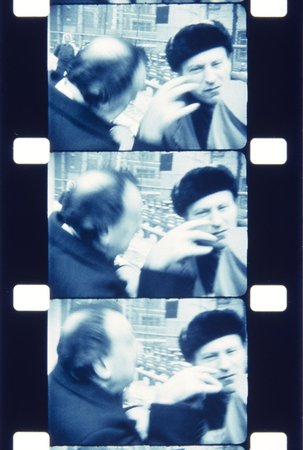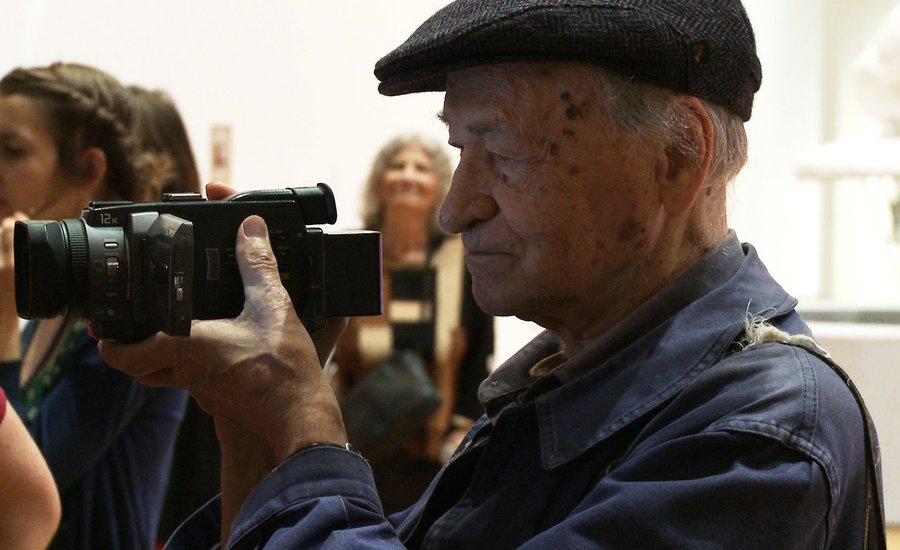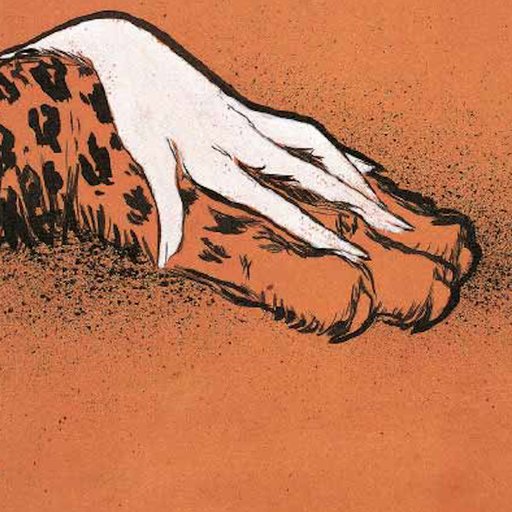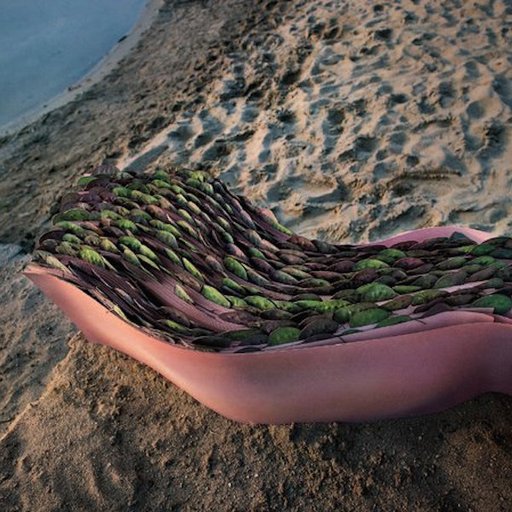In this excerpt from Phaidon’s Akademie X —a collection of lessons, stories, and practical advice from a range of experienced international artists—the 93-year-old avant-garde cinema pioneer Jonas Mekas lays out 13 simple steps to jumpstarting your budding career as a modern-day experimental filmmaker. For more information on Mekas’s storied life and colorful career, check out our in-depth two-part interview with him here and here .
1.
Today there are at least half-a-billion tools and gadgets for making motion pictures: film cameras, video cameras, computers, mobile phones, even Google glasses. Which means that practically anybody can make movies; just as anybody can write, dance, or sing.
While most singing, dancing, writing and, now, moving picture-taking/sending is just a part of normal “social activity,” there are always some of us who want, or are inexplicably driven, to go a step further and pursue the tradition established by the so-called Seven Arts, to which the art of motion pictures has now been added.
2.
If you’ve been bitten by the bug of cinema, I’d like to share with you the following thoughts that may be of some use upon embarking on that perilous journey that is your life.
3.
Cinema, like literature or painting, or any other art, can be envisioned as a big tree with many branches. Some are large, and some are small, and some are very small. What’s important is not to forget that, large or small, they all have their function and together make up the tree. Thus we have a large narrative or story-telling branch, itself branching out into still smaller branches such as western, film noir, musical, comedy, slapstick, etc.; and several branches that split into varieties of “real life”: journalism, cinéma vérité, television documentaries, and reports, even real-life serials and docudramas. Then there are different varieties of autobiographical and diaristic cinema (which I practice myself), and a branch known as “home movies” and a branch of essayistic cinema (practiced, say, by Chris Marker, Marcel Hanoun, and Peter Greenaway). And then there’s a cluster of smaller branches that deal with the non-narrative; one could call them “poetic” forms of cinema that in more ways than one correspond to the various different forms of poetry in literature (for example, the lyrical films of Marie Menken, Stan Brakhage’s Songs (1964–69), the films of Bruce Baillie); and branches that could be compared to letters and postcards that make up most of the output on YouTube, Facebook, and personal sites.
 Holy Fools (Salvador Dali)
, 2012
Holy Fools (Salvador Dali)
, 2012
4.
I believe that the two best ways to begin the journey are: one, to work with another filmmaker whose work you admire, and learn the art and craft the way the old Renaissance artists did or two, by acquiring a camera, any camera, and beginning to film/tape as a daily practice. Only by filming or taping will you begin to discover what kind of movies you want to make, towards which branch of the cinema tree you’re being pulled.
5.
Just as the reading of other poets is the best teacher for a young poet, in cinema the best school for a film-maker is to see films, both classic and contemporary, from all branches of the cinema tree. Find your closest venue screening the classics. And get to know the other young people who have the same dreams as you. Meet them at local film venues where they show their films/videos: don’t get lost in purely “commercial,” “public” cinema venues. It’s at the small independent venues that the excitement is generated, that new ideas are born.
6.
Read! Don’t ignore the history of your art. Don’t waste time trying to reinvent the wheel. Although it’s true that cinema begins anew with every buzz of our cameras, it’s also true that we’ve inherited an exciting body of cinema, representing all branches of the cinema tree. In a way, we’re branches of it, and we can grow only forwards, not backwards. I wouldn’t read the film magazines; they’ve all become very pedestrian. I’d say the same about most of the contemporary books on cinema. Read the early books, such as Paul Rotha’s The Film Till Now , Lewis Jacob’s The Rise of the American Film , the writings of Hans Richter, Jean Epstein, Dulac, the early (1900–15) Prague writers (if you can find them), Pudovkin, Arnheim. From the contemporaries, read Stan Brakhage’s Metaphors on Vision , P. Adams Sitney’s Visionary Film , Steve Dwoskin’s Film Is , Dominique Noguez, and my own Movie Journal . I recommend the early writings on cinema above the contemporary books for the boundless enthusiasm that the early writers had for the art of motion pictures, their passion, their visions, dreams that have been lost in the contemporary writings on cinema.
7.
Learn everything about the tools and technologies that go into the making and presentation of your art. Like musicians or painters, film/video makers have to have a thorough knowledge of what their chosen tool for making moving images can do, its capabilities, its limits, in order to use it to its maximum potential. (See Harmony Korine’s Trash Humpers (2009)—a movie “badly” made, “badly” edited, with “horrible” camera work, everything bad—but a masterpiece; and my own Notes on the Circus (1966)—for the vocabulary of what a Bolex camera can do.)
8.
MOVEMENT: Movement in cinema can now go from complete immobility ( Andy Warhol’s Empire , 1964) to a blurred swish (Michael Snow’s Back and Forth , 1969), to a million unpredictable speeds and ecstasies (Brakhage’s work, for example). The classic film vocabulary allows only respectably paced camera movements, the steadiness, the immobility that is called a “good,” “clear” image. But filmmakers have freed the camera motion. Camera movements can now go anywhere, from a clear, idyllic peacefulness to a frenetic ecstasy of motion. The full scale of our emotions can be registered and reflected—for ourselves, if for nobody else. The camera can be as feverish as our minds. There’s no such thing as “normal movement” or a “normal image”; there’s no “good” image or “bad” image. I don’t have to tell you that what I’m saying here goes radically against the accepted aesthetics of the classical and professional contemporary public cinema.
9.
LIGHTING/EXPOSURE: You can go from the “properly” exposed and lit image (as measured by the light meter) to the complete destruction of the “proper”; from a total whiteness (wash-out) to a total blackness. Endless nuances are now open to us, the poetry of shades, or over- and under-exposures. (See Apichatpong Weerasethakul’s Uncle Boonmee Who Can Recall His Past Lives , 2010.)
10.
We now know that there’s no such thing as one way of exposing (seeing) things; that the steadiness or sharpness or clarity (and all their opposites) aren’t virtues or absolute properties in themselves; that the cinema language, like any other language or syntax, is in constant flux, as our tools for making moving images and our ways of seeing reality change in complex mysterious and unpredictable ways. (See Harmony Korine’s Trash Humpers , George Kuchar’s The Weather Diaries , 1986–90, Isidore Isou’s Traité de bave et d’éternité , 1951.)
11.
And please, do not listen to those who say that analogue film is dead and long live the digital technologies! No, no, no! In Paris, London, New York, Tokyo, there are many, I repeat, many young people who still believe in what these days they call “analogue” cinema: the film, celluloid cinema, and they practice it. They know where to find 8-mm and 16-mm film stock, they create their own film-processing labs, they save old projection equipment, they encourage producers of film stocks to continue making 8-mm and 16-mm film. And they exchange their works through noncommercial film-makers’ cooperatives—Light Cone in Paris, Film-makers’ Cooperative in New York, Canyon Cinema in San Francisco, LUX in London, etc. You’ll find a lot of information on this subject by contacting Re:Voir in Paris. Film as film is here to stay!
12.
And lastly: honor your image format and your camera as you honor your mother and your father. A film made on 8-mm or 16-mm should always be shown as 8-mm and 16-mm, never transferred to any other format. The same goes for 35-mm and all other formats. A video work should be shown as a video, not molested by transferring it to film. Just as watercolors and oils come with their own particular, untranslatable properties, or a saxophone cannot be translated into a violin, film and digital formats come with their own untranslatable unique properties of technique, style and content. What you can do with your mobile phone you’ll never be able to do with your 35-mm camera.
13.
I’m writing these notes in Brooklyn, New York, and I think they’re perfectly sane and, if followed, would be profitable to anyone who wants to make movies. But I write them will full knowledge that in another place, known as Olympus, far away from Brooklyn, there are eight muses who have their own plans and one never knows who they’ll choose to enter you and drive you crazy: because once they enter you, you have no choice. Nor do you need any guidebooks. Journalists will ask you: how did you start and why? And you’ll have no answer.
 Elvis Presley, Madison Square Garden, New York, June 9, 1972. Last New York Concert
, 2010
Elvis Presley, Madison Square Garden, New York, June 9, 1972. Last New York Concert
, 2010
ASSIGNED READING AND VIEWING
I suggest that you keep away from theoretical books on cinema, at least for the first ten years of your work in film. They can mess you up and it will take long time to return back to yourself. My list includes books only where the authors, including myself, write about cinema like poets, with enthusiasm and excitement about the possibilities of cinema as an art and a discovery.
Reading:
Grierson, John.
Grierson on Documentary
. London: Collins, 1946.
— I chose this book for its visionary dreams of real-life cinema—cinema as a record of the reality around us.
Mekas, Jonas.
Movie Journal
. New York: Macmillan, 1972.
— I am including this volume of my own selected columns from the Village Voice so that you can understand where my mind and heart are regarding the art of moving images. I’m not a historian, nor a critic of cinema: I’m a lover of cinema!
Richter, Hans.
A History of the Avant Garde
. San Francisco: Art in Cinema, 1947.
— I chose this book for Hans Richter’s unrestrained, contagious enthusiasm for the possibilities of non-narrative, poetic, and abstract forms of cinema.
Rotha, Paul.
The Film Till Now
. London: Spring Books, 1967.
— This book was written when writers of film histories still wrote with a dreamer’s innocence about the young art of moving images.
Viewing:
Brakhage, Stan, dir.
Metaphors on Vision
. Film Culture, 1963. Film.
— This book by the great film poet presents his visionary insight into the workings of the human eye, human vision, as it struggles to record what it sees through art.
READ MORE FROM AKADEMIE X ON ARTSPACE:
6 Art-World Lessons From the Unorthodox Classroom of Akademie X
Chris Kraus on the Ambiguous Virtues of Art School
Words to Live By: Marina Abramović's Mystical Maxims for Artists
Venice Biennale Representative Joan Jonas's Workout Regimen for Artists
The Four-Hour Art Week? Read Carol Bove's Self-Help Guide for Artists
Sanford Biggers’s Tough-Love Guide to Surviving the Art World
Go On a New York City Scavenger Hunt With Artist Mark Dion
Ólafur Elíasson’s 9 Foolproof Tips for Urban Inspiration
Painter Carrie Moyer on Her Polyamorous Relationship With Art
Wangechi Mutu’s Words of Wisdom for Struggling Artists




























